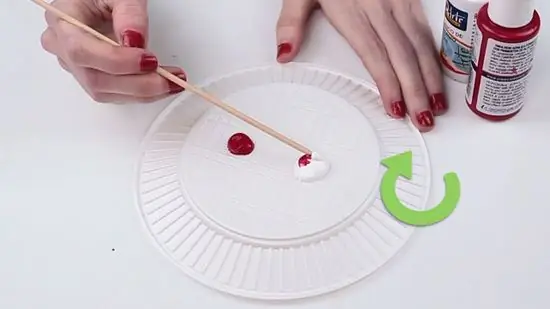- Author Jason Gerald [email protected].
- Public 2023-12-16 10:50.
- Last modified 2025-01-23 12:04.
The color palette is incomplete without pink. You can buy pink paint, but you can also easily make your own. In addition, you can also get the pattern you want, regardless of the painting or work you are working on. Start by preparing your favorite red paint, then add a little white or dissolve the paint. After that, you can create a variety of beautiful pink shades.
Step
Method 1 of 2: Creating a Pink Color with Oil or Acrylic Paints

Step 1. Choose a red color
Most standard red paint can be used to create a pink color. Each red produces a different shade of pink, so you can experiment first until you find a shade that you like. The red colors that are usually sold have general characteristics, so choose the color according to your needs.
- Cadmium reds (light, medium, and dark) produce a pinkish hue with orange undertones.
- The pink color produced by the red color of Scarlet Lake will appear very bright.
- The Alizarin Crimson color produces a bright pink color that appears slightly bluish and purplish.
- The Rose Madder color is a transparent hue that can be used to produce a light pink color.
- Naphthol Red color can produce a very bright transparent pink color.
- Quinacridone is a great color to mix with blue or gray to get a variety of shades of pink. When mixed with white, it produces a very light pink color.
- Earth reds (including Indian Red and Venetian Red) can be used to create natural looking pinks.

Step 2. Choose white paint
To make pink from acrylic, oil, or other types of paint that are usually opaque, you will need to mix red paint with white paint. However, not all white produces the same effect. For best results when mixing colors, choose a white that is opaque or slightly opaque (eg Titanium White). Transparent whites (eg Zinc White) will only lighten reds, without producing pinks.

Step 3. Add red paint to white paint
Pour white paint and red paint on the palette. Start by adding a little red paint to the white paint, and mix until evenly distributed. Keep adding red paint little by little until you get the pink hue you want to use.
Don't make pink by adding white paint to red paint as this process takes more time and paint

Step 4. Add a complementary color to darken the pink
Hues are technically created by adding black paint to a color. However, many painters feel that using complementary colors instead of black can produce colors that look more beautiful. You can add a direct complementary color (green). However, the use of complementary colors that are close together (eg blue) can also produce beautiful colors.
Whatever color you choose to darken the pink, add a little color at a time, then mix in the paint until you get the color or hue you want
Method 2 of 2: Creating a Pink Color Using Watercolor

Step 1. Choose a base color
There are a variety of ready-to-use watercolors that can be used to create a pretty pink color. You can use these paints directly and dilute them with a little water. Choose a base color like:
- Permanent Rose
- Quinacridone Rose
- Ruby Red

Step 2. Dilute the base color to lighten it
Watercolor works by using the white color on the paper to reflect light through the transparent paint layer used. To create a lighter pink, all you need to do is dilute the base color with enough water to make the paint layer look very transparent.
- Experiment with the amount of water used to thin the paint on the container before applying it to the paper. This experiment gives you an idea of the types or shades of pink that can be made.
- You can also wet the paper first, then use a little red paint to create a pink stroke.

Step 3. Use alternative colors to create a pink hue
Watercolor colors can produce a pretty color look when dissolved and applied to a basic pink. To add hue, use strokes of other colors such as Cobalt Blue on top of a layer of pink.
Using alternative colors other than black to create patterns will result in richer and brighter colors

Step 4. Use warm colors to lighten the pink
Coat the paper with a warm color first before you apply the pink to make the color appear warmer and lighter. A yellow wash can be an effective choice.

Step 5. Mix pink with red to make the color appear darker
If your base pink isn't as rich as you'd like, choose a darker red. Mix the color with pink or rose red in your paint palette or container, then dilute it until it's saturated to your liking.
Tips
- In general, the same principles or rules for mixing acrylic or oil paints apply when you mix wall paints.
- If you need a lot of pink to use as a paint color for your walls, you can order it from a professional paint mixer. It can be very difficult to get the same hue when you run out of pink before the painting is done.
- Several color combinations can produce a pink hue, without using white paint. For example, the colors Quinacridone and Hansa Yellow will produce a salmon pink color when mixed. Experiment to see if you can get the pink you want.






